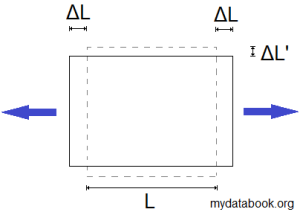Spotted an error on this page? Please help improve the quality of this site! E-mail: webmaster@mydatabook.org
Pages
- Home
- Fluid Mechanics
- Mathematics
- Solid Mechanics
- Thermodynamics
When a material is stretched in one direction, it will usually shrink in the other perpendicular directions.
The Poisson’s ratio, ![]() , is the ratio of transverse strain,
, is the ratio of transverse strain, ![]() to axial strain
to axial strain ![]() , where an axial force has been applied.
, where an axial force has been applied.
(1) ![]()
The strain of a material is defined as:
(2) ![]()
Where ![]() = change in length,
= change in length, ![]() = original length.
= original length.

Poisson’s ratio will typically be between 0 to 0.5 for most common materials.
Approximation for Very Small Strains
For very small changes in length, an approximation for Poisson’s ratio is:
(3) ![]()
Typical Poisson’s Ratios for Common Materials
| Material | Poisson’s Ratio |
| Aluminium | 0.32 – 0.35 |
| Aluminium Alloys | 0.32 – 0.35 |
| Boron Carbide (B4C) | 0.15 – 0.18 |
| Brass | 0.34 |
| Brick | 0.19 |
| Bronze | 0.34 |
| Carbon (Diamond) | 0.20 |
| Concrete | 0.2 |
| Copper | 0.33 – 0.35 |
| Cork | 0 |
| Glass | 0.2 – 0.22 |
| Gold | 0.4 |
| Iron | 0.22 – 0.3 |
| Magnesium | 0.29 |
| Nickel | 0.31 |
| Nylon | 0.39 – 0.42 |
| Platinum | 0.38 – 0.4 |
| Rubber | 0.49 |
| Silver | 0.37 |
| Solder (Tin-Lead) | 0.4 |
| Steel | 0.27 – 0.3 |
| Stone (Granite) | 0.2 – 0.3 |
| Stone (Limestone) | 0.2 – 0.3 |
| Stone (Marble) | 0.2 – 0.3 |
| Tin | 0.32 – 0.36 |
| Titanium | 0.32 |
| Tungsten | 0.28 |
| Zinc | 0.25 |
By continuing to use the site, you agree to the use of cookies. more information
The cookie settings on this website are set to "allow cookies" to give you the best browsing experience possible. If you continue to use this website without changing your cookie settings or you click "Accept" below then you are consenting to this.